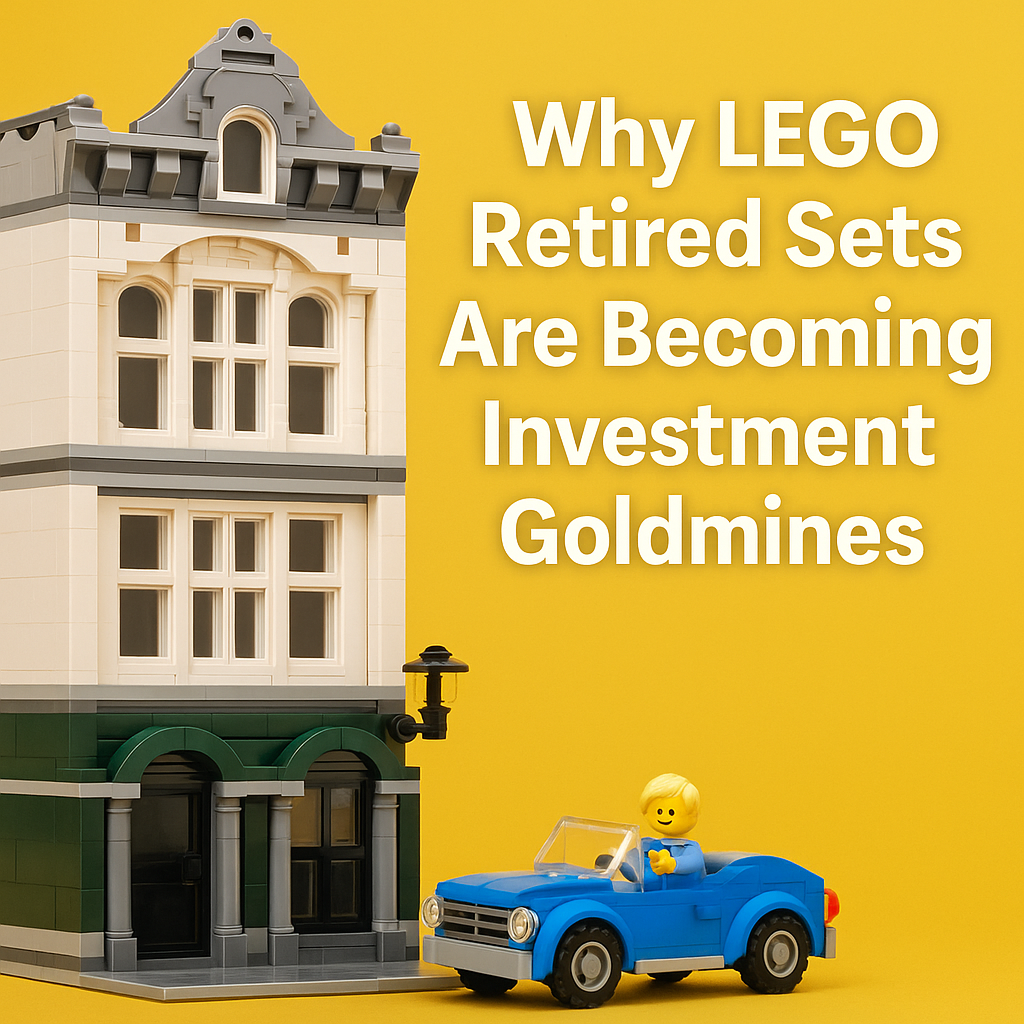Why LEGO Retired Sets Are Becoming Investment Goldmines
LEGO has become much more than a childhood pastime. Over the past decade, it has quietly evolved into one of the most reliable collectible investments in the market. People once viewed LEGO sets as simple building toys, but many now see them as valuable assets with the potential for impressive returns. The idea that a toy could outperform traditional investments like gold or real estate may sound surprising, yet LEGO has done exactly that in many cases. The reason behind this transformation lies in scarcity, nostalgia, collector demand, and the strength of the secondary market.

Scarcity is the key factor that drives up value. LEGO regularly retires sets to make room for new releases. Once a set is retired, production stops permanently, and the remaining stock becomes limited. This shortage leads to a predictable increase in demand as collectors rush to buy whatever remains. The price rise begins almost immediately and continues steadily over time. A set that once sold for $150 can easily fetch $400 or more within a few years of retirement. The scarcity effect works because LEGO never reissues most of its sets, which means collectors know that once a model is gone, it is gone for good. This certainty fuels buyer urgency and market competition.
Popular themes tend to hold and grow value faster. LEGO’s partnership with major franchises has helped make certain sets more desirable. Star Wars, Harry Potter, and Marvel themes dominate the resale charts, while modular buildings and Technic sets attract adult collectors. A set tied to a beloved film or cultural icon benefits from fan loyalty that persists long after production ends. For example, the LEGO Star Wars Millennium Falcon Ultimate Collector’s Edition originally retailed for around $500, but sealed versions now sell for several thousand dollars. This kind of appreciation is not rare among retired sets with strong fan bases. People are often willing to pay a premium to complete a collection or relive their favorite movie moments in brick form.
Nostalgia plays a powerful role in driving the market. Many adult fans of LEGO, often referred to as AFOLs (Adult Fans of LEGO), grew up playing with these sets and now have the disposable income to buy what they could not afford as children. This emotional connection creates strong, consistent demand. For some, it is about reliving childhood memories; for others, it is about sharing that joy with their own kids. This blend of nostalgia and affordability makes LEGO appealing to a wide age range. When emotions mix with limited supply, prices naturally climb higher. People are not just buying plastic bricks; they are buying a sense of comfort, creativity, and familiarity.
The secondary market has made LEGO trading accessible to everyone. Online platforms such as eBay, BrickLink, and Facebook Marketplace have created a thriving global ecosystem for LEGO investors and collectors. Sellers can easily reach buyers across different countries, and market prices adjust quickly based on supply and demand. Sealed sets are the most sought after, often selling within hours of being listed. Some serious collectors even track set values the same way investors monitor stocks, watching trends and predicting which themes will perform best. There are even data tools dedicated to LEGO investment tracking, which further proves how structured and competitive this market has become.
Historical data supports LEGO as a strong performing investment. Studies have shown that certain retired LEGO sets have appreciated at an average rate of 10 to 20 percent per year, outpacing many traditional asset classes. For example, the LEGO Café Corner modular building, which originally retailed for about $150 in 2007, now sells for well over $2,000 if unopened. Another example is the LEGO Taj Mahal, a massive architectural set that gained huge collector interest after its retirement, reaching values far beyond its initial retail price. These consistent returns demonstrate that LEGO investments are not a temporary trend but a proven pattern built on predictable collector behavior.
Limited edition and exclusive sets are especially profitable. Sets released in small quantities or sold only at events or specific stores tend to perform the best after retirement. Their rarity and exclusivity make them highly desirable among collectors. These sets often become status symbols within the LEGO community, representing both prestige and commitment. For instance, sets distributed only to employees or released for special anniversaries can sell for many times their original price. The smaller the production run, the greater the potential profit, as the scarcity effect is magnified.
Condition is a major factor in determining resale value. A sealed, unopened box in mint condition commands the highest price. Collectors are extremely sensitive to packaging details such as box dents, faded colors, or damaged seals. A single tear in the plastic wrap can reduce a set’s value significantly. Investors who handle their inventory carefully can maintain long-term profit potential. Proper storage is essential: keeping boxes in cool, dry spaces away from direct sunlight preserves both condition and value. Some collectors even use climate-controlled rooms for large collections, treating LEGO storage as seriously as fine art preservation.
Media influence often creates sudden value spikes. When a movie franchise returns with new installments, or when LEGO releases a related anniversary product, older sets tied to that theme often see sharp increases in price. For instance, every time a new Star Wars film premieres, demand for classic LEGO Star Wars sets rises. The same effect happens with television shows, anniversaries, and pop culture revivals. Media exposure keeps these sets relevant, even years after their initial release, giving investors opportunities to capitalize on short-term demand surges.
LEGO’s trusted brand reputation adds stability to the market. LEGO is one of the few companies that has maintained quality, consistency, and customer loyalty for decades. Collectors trust that every set, no matter how old, will still fit perfectly with modern bricks. This backward compatibility creates confidence that no purchase is wasted. The brand’s commitment to precision and durability means that even decades-old bricks can look and function like new. This reliability reinforces long-term investment confidence, as buyers know they are acquiring a high-quality, enduring product.
The collector community helps sustain long-term value. LEGO has built a strong global fan base supported by conventions, online forums, and social media groups. Enthusiasts regularly share collection photos, discuss prices, and exchange investment advice. This active engagement keeps demand steady and awareness high. The social aspect also strengthens emotional attachment, making LEGO collecting feel like membership in an international community. As more adults join this hobby, the demand for older sets continues to grow, which keeps the secondary market healthy and competitive.
LEGO investing combines creativity, nostalgia, and financial opportunity. It gives people a chance to hold something tangible while watching its value increase over time. It appeals to both emotional and financial motivations, creating a unique blend of passion and profit. Unlike many collectibles that rely on speculation, LEGO has a consistent buyer base and measurable market trends that investors can analyze. The fact that LEGO sets often appreciate faster than traditional assets shows how strong the demand really is.
In conclusion, LEGO retired sets have proven to be modern investment goldmines. Their value comes from a clear combination of scarcity, emotional appeal, and collector demand. The market has shown steady growth, with no sign of decline. For those who pay attention to retirement schedules, popular themes, and proper storage methods, LEGO can offer an enjoyable and profitable investment path. What began as a simple toy has turned into a serious financial opportunity-proof that creativity, nostalgia, and smart timing can turn colorful plastic bricks into lasting wealth.




